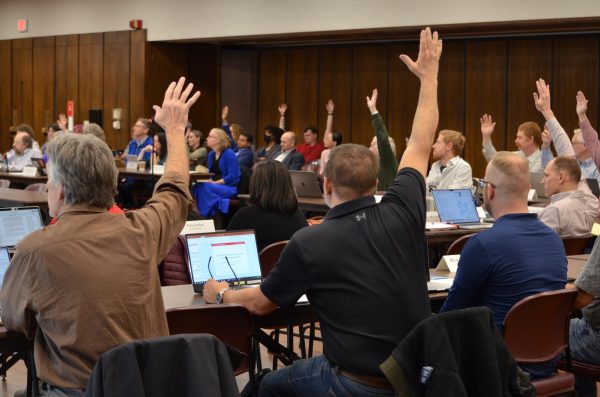- News
- News / Politics And Administration
- News / Politics And Administration / Campus
- News / Politics And Administration / City
- Politics
Local officials share ISU train derailment plan
Over the past three years, Iowa has averaged 33 derailments.
Local officials considered the event of an ISU train derailment in light of the recent train derailment in East Palestine, Ohio, that gained attention nationwide. Iowa averaging 33 derailments over the past three years and trains frequently run through Iowa State University.
Initial Response
The response would start with the Ames Fire Department as the primary hazmat response and the Iowa State Police Department ensuring the safety of people in the area, which Ames Fire Chief Rich Higgins said is his top priority.
“What we’re doing when we first get on scene is we’re sizing up the incident—how big is this, [and are there] any immediate life safety concerns that we need to take care of right now,” Higgins said.
Assistant Chief of Iowa State Police Carrie Jacobs said Iowa State Police would first check to see if the scene is hazardous and then assess the wind direction to keep the scene safe.
Jacobs also said they would utilize the ISU Alert system to inform people in the area whether to shelter in place or evacuate. She added that the department receives a daily manifest of what trains are carrying.
“That would be a really bad day, but that’s what we train for,” Jacobs said.
In addition to ISU Alert, Story County Emergency Management Coordinator Melissa Spencer said the county may use the Story County Iowa Alerts system.
Iowa State Emergency Manager Clayton Oliver said in the event of a derailment, sheltering in place is preferable over an evacuation.
“Every time you put thousands of people on the road with no notice, and they perceive there is an immediate threat, you’re going to have traffic accidents; you’re going to have secondary issues,” Oliver said. “So, if we can just have everyone close doors and windows, shut off their air conditioning and move to the highest level of the building they’re in for a couple of hours until whatever outside is contained or dissipates, that’s preferable to an evacuation.”
Depending on where the train derails, Stange Road, Haber Road and pedestrian walkways between 13th Street and University Boulevard could be closed. Jacobs and Higgins said this would result in area command units on both sides of the tracks.
During the 2021 train derailment in Ames, Spencer said Story County Emergency Management assisted in lending additional equipment like walkie-talkies to first responders.
“We have a 26-foot trailer that can be used by any jurisdiction in our county to carry out their command operations in an environmentally controlled environment,” Spencer said.
Also, in 2021, Story County Sheriff’s Office Sgt. Gary Backous said in email communications with the Daily that drones were used in the initial response.
“We were able to identify which car was leaking and [what] the substance was without putting any responders in immediate harm,” Backous stated. “We were also able to help show incident commanders the extent of the damage so they could coordinate the response.”
Union Pacific, who owns the train tracks that go through Ames, would also be involved in the response, according to Ames Public Works Operations Manager Justin Clausen.
“Within 90 minutes of the initial derailment, Union Pacific had equipment to help clean up with the derailment on site,” Clausen said. “If you contrast that to what you hear going on in Ohio […] I feel like our response was completely different. We were in constant communication with the railroad, and we were always meeting with them.”
Secondary Response
Higgins said after life safety concerns, the next issue is working on possible released toxins.
“Is there some type of chemical release? Is one of the cars carrying a hazardous material that we need to start thinking about evacuation of certain areas?” Higgins said. “Is there fire imminent; is there any type of explosion hazard, any type of extenuating traffic hazards?”
Jacobs said she was concerned about a possible structure collapse in the area around the tracks.
“Frederiksen Court [and] the buildings that are closest to the tracks [could be at risk], now granted depending on the type of derailment, the amount of energy and force that is utilized,” Jacobs said. “I do get concerned about how close [those buildings are] because if we ever do have an intrusion […] we might have a structure collapse, [and we] might have people trapped within the building.”
Oliver said that some buildings may need to be replaced depending on the extent of the damage.
“For facilities impact, it depends on whether we had a hazmat release or whether the impacts were primarily physical and where it happened and how big and bad it was,” Oliver said. “Obviously, if we’ve got a car full of citrus parked in the horse barn, we’re going to need to rebuild the horse barn.”
Oliver said a derailment could involve no hazmat action with non-toxic contaminants or just waiting 24 hours for a substance to dissipate, but in the event of serious contamination occurring, Frederiksen Court may need to be evacuated.
“Let’s say we do have Frederiksen Court impacted; however many students are displaced out of there, they still have residential contracts that we need to honor,” Oliver said. “If they’ve had to evacuate, most of them have probably left a large amount of personal property behind.”
Oliver said especially if a derailment happens at night, students may have left phones and IDs, and international students may have left passports behind. He said the university would have to find a way to help replace those documents in the event students cannot return to their apartments.
Jacobs and Oliver said if there was a silver lining to dealing with COVID-19, housing displaced students and rearranging classes could be it.
“The good news is that we have fairly extensive recent experience doing that throughout COVID as we were shuffling spaces around and rearranging 3,000 classes to make sure we had classroom occupancy at an appropriate level,” Oliver said.
After the response
Oliver and Jacobs said mental health resources would be available to students, including Iowa State University Police Department mental health advocates and Iowa State Student Counseling Services. Oliver added that they would likely ask local mental health organizations to aid in the response and, if needed, they could ask the state for their short-term assistance team.
Spencer said the Story County Emergency Management would be looking at the bigger picture, like helping provide state resources.
“Looking at this, OK, do we need to feed people? Do we need to get some of our partners, such as Red Cross, up here to shelter people?” Spencer said.
Depending on road and pedestrian walkway closures, students may need to find a new way to get to class.
“The bigger issue is making sure students who do not have any other way to get to class other than bus or bicycle that they’re aware of those alternate routes,” Jacobs said. “Obviously CyRide will be given a new route, and that may mean we might have to add another bus to that route depending on what the situation is.”
Clausen estimated in 2021, it took eight to 10 weeks to complete scrapping and removing the 27 train cars that derailed, meaning housing displacement and road and pedestrian walkway closures could last just as long.
Clausen also said as the primary point of contact for the city, Union Pacific met with him in the weeks following, and when he noticed a presumed empty train car was leaking something, Union Pacific responded in about 90 minutes.
Overall Preparedness
Higgins, Jacobs, Oliver and Spencer all agreed that they are prepared in the event of a train derailment and that ongoing training is beneficial.
“A plan is not going to cover everything that can possibly happen; a plan is a starting point for improvisation, but planning is really the art of making decisions in advance,” Oliver said. “I don’t get paid to be an optimist. I get paid to spend all day staring into the Hellmouth and going, ‘Okay what can go wrong, and how can we keep it from getting really bad?’”
Higgins and Spencer said that the 2021 derailment response was successful and that they improved their plans afterward.
“You never want to have an emergency in your community, but when you do, it would be a real fault of your department not to learn from that incident to see what you can do better next time,” Higgins said.
Higgins said one improvement made would be to get Story County drones to the scene sooner to better assess the situation.
Clausen, Higgins, Jacobs, Oliver and Spencer all said that relationships with each other are important in responding to an event like this.
“Those relationships are so important,” Higgins said. “We all work together to serve the community, and especially during an emergency, that’s when we need to highlight those relationships that you have to best serve the community and mitigate the risk as quickly as possible.”
Spencer said, in addition to local partners, that she is also familiar with hazardous materials employees at Union Pacific.
“Having that first name basis and knowing who each other are before that incident happens is hugely valuable when something does go wrong,” Spencer said.
Your donation will support the student journalists of the Iowa State Daily. Your contribution will allow us to purchase equipment, send our student journalists to conferences and off-set their cost of living so they can continue to do best-in-the-nation work at the Iowa State Daily.













